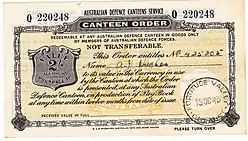Postal order
A postal order, postal note or money order is a financial instrument usually intended for sending money through the mail. It is purchased at a post office and is payable at another post office to the named recipient. A small fee for the service, known as poundage, is paid by the purchaser. In the United States, this is known as a postal money order. Postal orders are not legal tender, but a type of promissory note, similar to a cheque.

History

The postal order is a direct descendant of the money order, which had been established by a private company in 1792. During World War I and World War II, British postal orders were temporarily declared legal tender to save paper and labour. Postal orders can be bought and redeemed at post offices in the UK, although a crossed postal order must be paid into a bank account.[1] Until April 2006 they came in fixed denominations but due to increased popularity they were redesigned to make them more flexible and secure. They now have the payee and value added at the time of purchase, making them more like a cheque. There is a fee for using this form of payment. The maximum value of postal order available is £250.00 with the fee capped at £12.50.[2]
Use in other countries

The use of postal orders (or postal notes in some countries) was extended to most countries that are now part of the British Commonwealth of Nations, plus to a few foreign countries such as Jordan, Egypt and Thailand.[3]
United States
United States Postal Money Service were introduced in 1864 by an act on Congress as a way of sending small amounts of money through the mail.[4] By 1865 there were 416 post offices designated as money order offices that had issued money orders to the value of over $1.3 million and by 1882 they has issued orders valued at $113.4 million from 5,491 money order offices.[5]
Currently they facially appear as a draft against an account held by the United States Postal Service, and the United States Postal Service requires a purchaser to know, in advance, where presentment of the instrument will occur. Only special, more expensive United States International Postal Money Orders may be presented abroad. In the United States, international money orders are pink and domestic money orders are green.[6]
Canada
Canada had its own postal orders (called postal notes) from 1898 until 1 April 1949, when these were discontinued and withdrawn.
A British Forces Post Office in Suffield, Alberta was issuing British postal orders as late as July 2006.
China
Chinese Imperial Post began issuing postal orders since 1897, the so-called "remittance certificate". After purchase, these certificates are payable at main post offices in China and usually bearing franked postage stamps represented as fee. Since 1925, a set of special stamps were used by post offices to issue secured postal orders.[7] Since 1929, Chinese Post were capable of selling international postal orders cashable under UPU protocol at a few other countries including Japan, Britain, France, and the US.
Australia

A Defence canteen order was a variant of a postal order used in Australia during World War II. Purchased at a post office, it was payable to an enlisted person in goods from a canteen rather than being a cash instrument.[8]
Collecting
Postal orders are gaining in popularity as collectibles, especially among numismatists who collect banknotes.
There is an active numismatic organisation in the UK called the Postal Order Society that was established in 1985 with members both domestically and overseas. They hold twice-yearly postal auctions of postal orders and related material from across the British Commonwealth.
Advantages
Despite competition from cheques and electronic funds transfer, postal orders continue to appeal to customers, especially as a form of payment for shopping on the Internet, as they are drawn on the Post Office's accounts so a vendor can be certain that they will not bounce. They also enable those without a bank account, including minors, to make small financial transactions without the need for cash. Postal workers in the United Kingdom use voided or cancelled orders in their training.[9]
See also
- George Archer-Shee, whose court case inspired Terence Rattigan's play The Winslow Boy.
- List of countries that have used postal orders
- Promotional postal order
References
- "Postal orders". Post Office Ltd. 2013. Retrieved 2013-01-28.
- "Fee structure". Post Office Ltd. 2013. Retrieved 2013-01-28.
- Reid, Donald M. (1984). "The Symbolism of Postage Stamps: A Source for the Historian" (PDF). Journal of Contemporary History. 19 (2): 223–249. doi:10.1177/002200948401900204. JSTOR 260594. S2CID 159682377.
- United States Official Postal Guide. Washington DC: United States Post Office Department. July 1925. p. 93.
- Annual Report of the Postmaster General. Washington DC: United States Post Office Department. 18 November 1882. p. 391.
- https://about.usps.com/publications/pub100.pdf
- Fuerst, Robert. E (1976). Catalogue of the Money Order Stamps of China (Pagoda Design).
- https://www.abs.gov.au/ausstats/abs@.nsf/featurearticlesbytitle/6434743F9AB1A2D4CA2569DE0020331B?OpenDocument
- "Another view" by Douglas Myall in British Philatelic Bulletin, Vol. 51, No. 5, January 2014, pp. 149-151.
Further reading
- Lunn, Howard. (1984) A Guide to the History and Values of British Postal Orders 1881-1984. Howard Lunn.
- Lunn, Howard. (1997) Promotional Postal Orders. East Stour, Gillingham: Howard Lunn.
External links
| Wikimedia Commons has media related to Postal orders. |
